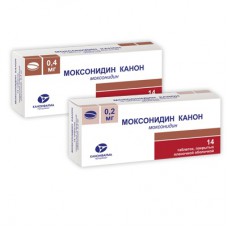Expiration date: 03/2026
Dosage form:
Tablets, film-coated
Composition:
1 tablet, film-coated, contains:
the dosage is 0.2 or 0.4 mg: active substance: moxonidine 0.2 or 0.4 mg
excipients (core): croscarmellose sodium (Primerose) -,
3.0 mg, lactose monohydrate (ektapress) (milk sugar) is, 95,1 mg, silicon dioxide colloidal (Aerosil) -, 0.5 mg, sodium fumarate -, 1.0 mg,
excipients (shell): Opadry II (polyvinyl alcohol, partially hydrolyzed -, of 1.32 mg, titanium dioxide E 171 -, 0,5751 mg, talc -, 0.6 mg, macrogol (polyethylene glycol 3350) -, 0,3705 mg, soy lecithin E 322 -, 0,105 mg, aluminum lacquer based Indigo -, 0,0018 mg, aluminum lacquer dye azorubin -, 0,0153 mg, aluminum lacquer dye crimson [Ponceau 4R] -, 0,0123 mg).
Description
Tablets, film-coated light pink color, round, lenticular. Pills to break white or nearly white (dosage 0.2 mg).
Tablets, film-coated dark pink, round, lenticular. Pills to break white or nearly white (dosage 0.4 mg).
Pharmacotherapeutic group of the medicinal product:
Antihypertensive Central action.
Code ATX: [?02??05]
Pharmacodynamics
Moxonidine is an antihypertensive agent with Central mechanism of action. In the stem structures of the brain (Rostral layer of the lateral ventricles) moxonidine selectively stimulate imidazoline-sensitive receptors are involved in tonic and reflex regulation of the sympathetic nervous system. Stimulation them gasolinevin receptors reduces peripheral sympathetic activity and blood pressure (BP).
Moxonidin different from other simpatoliticakim antihypertensives lower affinity for ?2-adrenergic receptors, which explains the lower likelihood of sedation and dry mouth.
Receiving moxonidine leads to a reduction in systemic vascular resistance and blood pressure.
Moxonidine improves 21% the index of insulin sensitivity (compared to placebo) in patients with obesity, insulinrezistentnost and moderate arterial hypertension.
Pharmacokinetics
Absorption: After intake of moxonidin rapidly and almost completely absorbed in the upper gastrointestinal tract. Absolute bitstop-ness is approximately 88 %. The time to maximum concentration, about 1 hour. Food intake does not influence the pharmacokinetics of the drug.
Distribution
Relationship with blood plasma proteins is 7.2 %.
Metabolism
The main metabolite, dehydrated moxonidin. Pharmacodynamic activity of moxonidine digidrirovannoe-about 10% compared to moxonidine.
Excretion
The elimination half-life (T1/2) of moxonidine and metabolite is 2.5 and 5 hours, respectively. Within 24 hours more than 90% of moxonidine is excreted by the kidneys (about 78% unchanged and 13% in the form of dehydra-relaxandia, other metabolites in the urine do not exceed 8 % of the dose). Less than 1% of dose extracted through intestine.
Pharmacokinetics in patients with hypertension:
Compared with healthy volunteers, patients with hypertension is not marked changes in the pharmacokinetics of moxonidine.
Pharmacokinetics in the elderly
Clinically insignificant changes in the pharmacokinetic parameters of moxonidine in elderly patients, probably due to the decrease in the intensity of its metabolism and/or slightly higher bioavailability.
Pharmacokinetics in children
Moxonidin not recommended for use in patients under 18 years of age, therefore this group pharmacokinetic studies were not conducted.
Pharmacokinetics in renal failure
The excretion of moxonidine is heavily correlated with creatinine clearance (CC). In patients with moderate renal insufficiency (QC in the range of 30-60 ml/min) equilibrium concentration in plasma and the final T1/2 is approximately 2 and l,5 times higher than in patients with normal renal function (QC over 90 ml/min).
In patients with severe renal insufficiency (KK less 30 ml/min), equilibrium concentrations in blood plasma and the final T1/2 is 3 times higher than in patients with normal renal function. The appointment of multiple doses of moxonidine leads to predictable cumulation in the organism of patients with moderate and severe renal insufficiency. In patients with end-stage renal failure (KK less 10 ml/min), hemodialysis, equilibrium concentrations in blood plasma and the final T1/2, respectively 6 and 4 times higher than in patients with normal renal function. In all groups the maximum concentration of moxonidine in plasma above 1.5 - 2 times. In patients with impaired renal function dosage should be chosen individually. Moxonidin to a small extent is excreted during hemodialysis.
Indications for use
Hypertension.
Contraindications
- hypersensitivity to the active substance and other components of the drug,
- syndrome of weakness of sinus node,
- expressed aetiology (heart rate of rest of less than 50 beats/min),
- atrioventricular block II and III degree,
- severe heart rhythm disturbances,
- acute and chronic heart failure (III-IV functional class NYHA classification),
- concurrent use with tricyclic antidepressants (see section "Interaction with other medicinal products"),
- severe renal insufficiency (KK less 30 ml/min),
- hemodialysis
- lactation,
- hereditary lactose intolerance, lactase deficiency or malabsorption of glucose-galactose
- age over 75 years,
- the age 18 years (due to the lack of data on safety and effectiveness).
With caution
It is necessary to observe special caution in the use of moxonidine in patients with atrioventricular block I degree (risk of bradycardia), severe disease of the coronary vessels, severe ischemic heart disease or unstable angina (experience of failure), chronic heart failure, severe liver failure, impaired renal function (QC over 30 ml/min).
Use during pregnancy and breastfeeding
Pregnancy
Clinical data on the use of Moxonidine in pregnant women are lacking.
In animal studies it was established embryotoxic effect of the drug. Moxonidin should be prescribed to pregnant women only after careful evaluation of the balance of risks and benefits when benefit to the mother outweighs the potential risk to the fetus.
Lactation
Moxonidin passes into breast milk and therefore should not be administered during breast-feeding. If necessary, the use of Moxonidine during lactation, breastfeeding should be discontinued.
Method of application and doses
Inside, regardless of meals. In most cases, the initial dose of the drug Moxonidin is 0.2 mg per day. The maximum single dose is 0.4 mg. Maximum daily dose, which should be divided into 2 doses is 0.6 mg. of the Required individual correction of a daily dose depending on the tolerability of the patient the therapy. Dosage adjustment for patients with hepatic impairment is not required. The initial dose for patients with moderate or severe renal insufficiency is 0.2 mg/day. If necessary and if tolerated, the daily dose may be increased to a maximum of 0.4 mg.
Side effects
The frequency of side effects listed below were determined according to the following: very often (>,1/10), often (>,1/100, <,1/10), infrequently (>,1/1000, <,1/100), including an individual message.
From the Central nervous system:
Common: headache*, dizziness (vertigo), drowsiness.
Uncommon: fainting*.
From the side of cardiovascular system:
Uncommon: marked reduction in blood pressure, orthostatic hypotension, and bradycardia.
The gastro-intestinal tract.
Very common: dryness of the mucous membrane of the oral cavity.
Often: diarrhea, nausea, vomiting, dyspepsia.
The skin and subcutaneous tissues:
Frequent: skin rash, itching.
Uncommon: angioedema.
Mental disorders:
Frequent: insomnia.
Uncommon: nervousness.
On the part of the organ of hearing and labyrinth disorders:
Uncommon: ringing in the ears.
From the musculoskeletal and connective tissue:
Frequent: back pain.
Uncommon: pain in the neck.
General disorders injection site:
Frequent: asthenia.
Uncommon: peripheral oedema.
(*frequency comparable to placebo).
Overdose
There are reports of several cases of overdose without a fatal outcome, when simultaneously applied dose to 19.6 mg.
Symptoms:
headache, sedation, marked reduction in blood pressure, dizziness, asthenia, bradycardia, dryness of the mucous membrane of the mouth, vomiting, fatigue, epigastric pain, respiratory depression and impaired consciousness. In addition, it is also possible short term increase in blood pressure, tachycardia, and hyperglycemia have been shown in several studies high doses in animals.
Treatment
There is no specific antidote. In the case of pronounced blood pressure reduction may require the restoration of circulating blood volume by introducing a fluid and dopamine (injectable).
Bradycardia can be abolished by atropine (injection).
In severe cases of overdosage it is recommended to carefully control the disturbances of consciousness and prevent respiration.
Antagonists of alpha-adrenergic receptors can reduce or eliminate paradoxical hypertensive effects in overdose moxonidine.
Moxonidin to a small extent is excreted during hemodialysis.
Interaction with other drugs
The combined use of moxonidine other antihypertensives leads to additive effect. Tricyclic antidepressants may reduce the effectiveness of antihypertensives Central action, therefore it is not recommended taking them together with moxonidine.
Moxonidine can increase the effects of tricyclic antidepressants, tranquilizers, ethanol, sedatives and hypnotics.
Moxonidin able to weakened moderately improve cognitive function in patients receiving lorazepam.
Moxonidine may enhance sedative effect of benzodiazepines at their simultaneous appointment.
Moxonidine excreted by tubular secretion. Therefore, it is possible its interaction with other drugs released by tubular secretion.
Beta-blockers enhance the bradycardia, the severity of the negative foreign and dromotropony action.
Special instructions
If you need to cancel at the same time taken beta-blockers and drug Moxonidin, first cancel beta-blockers and only a few days Moxonidin.
Currently, there is no evidence that the cessation of drug Moxonidin leads to increased blood pressure. However, it is not recommended to stop taking the drug Moxonidin abruptly, instead gradually reduce the dose of the drug for two weeks.
During treatment to eliminate alcohol consumption.
During treatment requires regular monitoring of heart rate and electrocardiography.
Effects on ability to drive vehicles and management mechanisms
The effect of Moxonidine on the ability to drive vehicles or the management technique was not investigated. However, taking into account the possibility of dizziness and drowsiness, patients should exercise caution in potentially hazardous activities, require increased attention such as driving or controlling machinery that requires high concentration.
Release form
Tablets, film-coated, 0.2 mg and 0.4 mg
For 14 or 28 tablets in a contour cell package.
Shelf life
3 years. Do not use after the expiry date printed on the package.
Storage conditions
In a dry, protected from light place, at temperature not exceeding 25°C.



